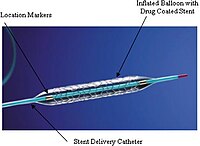
Photo from wikipedia
To ensure the biomechanical properties of Ti-24Nb-4Zr-8Sn, stress-shielding effects were compared between Ti-24Nb-4Zr-8Sn and Ti-6Al-4V fixation by using a porcine model. Twelve thoracolumbar spines (T12–L5) of 12-month-old male pigs were… Click to show full abstract
To ensure the biomechanical properties of Ti-24Nb-4Zr-8Sn, stress-shielding effects were compared between Ti-24Nb-4Zr-8Sn and Ti-6Al-4V fixation by using a porcine model. Twelve thoracolumbar spines (T12–L5) of 12-month-old male pigs were randomly divided into two groups: Ti-24Nb-4Zr-8Sn (EG, n = 6) and Ti-6Al-4V (RG, n = 6) fixation. Pedicle screw was fixed at the outer edge of L4-5 vertebral holes. Fourteen measuring points were selected on the front of transverse process and middle and posterior of L4-5 vertebra. Electronic universal testing machine was used to measure the strain resistance of measuring points after forward and backward flexion loading of 150 N. Meanwhile, stress resistance was compared between both groups. The strain and stress resistance of measurement points 1, 2, 5, 6, 9, and 10–14 in Ti-24Nb-4Zr-8Sn fixation was lower than that of Ti-6Al-4V fixation after forward and backward flexion loading (P < 0.05). The strain and stress resistance of measurement points 3, 4, 7, and 8 was higher in Ti-24Nb-4Zr-8Sn fixation than that of Ti-6Al-4V fixation (P < 0.05). Stress-shielding effects of Ti-24Nb-4Zr-8Sn internal fixation were less than that of Ti-6Al-4V internal fixation. These results suggest that Ti-24Nb-4Zr-8Sn elastic fixation has more biomechanical goals than conventional Ti-6Al-4V internal fixation by reducing stress-shielding effects.
Journal Title: BioMed Research International
Year Published: 2018
Link to full text (if available)
Share on Social Media: Sign Up to like & get
recommendations!